Also In This Issue:

Trends in Drug Use
Behind the Vaping Epidemic

FACES OF HOPE SOS Berks Mural Project SUMMER 2023
Read It Online


The Response is published through funding from county and state dollars in concert with the Berks County Opioid Coalition under the guidance of the Council on Chemical Abuse. cocaberks.org • 610-376-8669
EDITORIAL BOARD
T.J. Huckleberry Executive Officer, Berks County Medical Society
Michael Rivera Commissioner, County of Berks
Katheen Noll Executive Director, Council on Chemical Abuse
Marcia Goodman-Hinnershitz Director of Planning & Resource Development, Council on Chemical Abuse
Tracy Hoffmann Hoffmann Publishing Group

Lee Olsen Olsen Design Group Architects
BERKS COUNTY’S OPIOID COALITION, SOS BERKS www.sosberks.com
SOS BERKS BERKS OPIOID COALITION LEADERSHIP
Michael Rivera and Kathleen Noll Coalition Co-chairs
COMMUNITY SAFETY COMMITTEE
John Adams and Yvonne Stroman Co-chairs
COMMUNITY AWARENESS COMMITTEE
Laura Catalano, Chair
DATA COMMITTEE
Justin Loose and Kathleen Noll Co-chairs
PREVENTION EDUCATION COMMITTEE
Cory Trevena and Jaclyn Steed Co-chairs
TREATMENT COMMITTEE
Amanda Miller and Bernice Hines-Corbit, Co-chairs
The opinions expressed in this publication are for general information only and are not intended to provide specific legal, medical or other advice or recommendations for any individuals.
All rights reserved. No portion of this publication may be reproduced electronically or in print without the expressed written consent of the publisher or editor.


OPIOID COALITION VISION
Identify opportunities to remediate the opioid crisis through the provision of evidence based/best practice strategies and resources.
OPIOID COALITION MISSION
The mission of the coalition is to determine the extent to which Berks County is being affected by the non-prescriptive use of opioids and the use of heroin through the examination of its devastating effects, both personal and societal, and to set recommendations that address the prevention, intervention, treatment and recovery supports of local residents that suffer from opioid addiction. 2669 Shillington
RECEIVE THE LATEST UPDATES BY FOLLOWING US ON SOCIAL MEDIA


3
HoffPubs.com
(610) 685.0914 Designer
FOR ADVERTISING
ext. 210 READ THE RESPONSE ONLINE AT Response.HoffmannPublishing.com FEATURES
Meet the New Co-Chairs of SOS Berks Opioid Coalition
Way of Remembrance
New trends in substance abuse stem from dangerous lab-made synthetic drugs 10 Behind the Vaping Epidemic 14 Care and Compassion: Unraveling the Parent/Child Communication Struggle 18 The 2023 Berks Medical Society Prescription Take-back Day 20 SOS Berks Mural Project 24 “Walking in My Shoes”: The Recovery Simulation Experience 26 Harm Reduction – Taking stigma away from Narcan and Fentanyl Strips 29 Counterfeit Pills Fact Sheet 30 What is Fentanyl? CONTENTS SUMMER 2023 BERKS COUNTY OPIOID COALITION
Road, Box #438 Sinking Spring, PA 19608 |
|
| Kim Lewis
INFO CONTACT: Alicia@hoffpubs.com, 610.685.0914,
4
6
8
Meet the New Co-Chairs of SOS Berks Opioid Coalition
By Co-Chairs Commissioner Michael Rivera and Kathleen Noll, Executive Director of the Council on Chemical Abuse
As the new Co-chairs of SOS Berks Opioid Coalition, we wanted to take this opportunity in this issue of The Response to introduce ourselves and express our commitment to the work of SOS Berks. First, we would like to express our thanks to the previous Co-chairs of SOS Berks, Kevin Barnhardt and Stanley Papademetriou. In December 2022, it was announced that Kevin Barnhardt would take over as Berks County’s Chief Operations Officer and Stan announced his retirement as the Executive Director of the Council on Chemical Abuse (COCA).

As Kevin and Stan were starting new chapters in their lives, they both had to step down as the Berks SOS Co-chairs. Kevin served as the Co-chair of SOS Berks since it began in 2016 and Stan became the co-chair in 2017 when the initial Co-chair, George Vogel, retired from COCA. Kevin and Stan remained committed to the mission of SOS Berks during their tenures as Co-chairs. They provided guidance and direction to the Coalition and kept the members of SOS Berks focused and committed to our work. We think we can speak for the SOS Berks membership when we say their leadership and input will be missed. We would also like to thank Kevin’s Executive Assistant, Jessica Blauser, for the work she did for SOS Berks. We wish Kevin, Stan and Jessica well in their new endeavors.
Introducing new Berks SOS Co-Chair Commissioner Michael Rivera:

When I was approached about serving as the Co-chair of SOS Berks, I immediately said yes. As a Berks County Commissioner for the past three years, I am well aware of the work the SOS Berks Opioid Coalition is doing to prevent overdose deaths and eliminate the stigma that surrounds addiction. I am also well aware of the devastation that substance use and addiction can cause. Individual lives are devasted and in many cases lost, families are torn apart and the entire community suffers.
In an effort to remediate and prevent this devastation, in my tenure as County Commissioner, I have supported and will continue to support prevention, intervention and treatment efforts as well as recovery initiatives. I also have a personal connection to issues surrounding substance use and addiction through my father’s recovery and I participate in events like the annual Recovery Walk to promote the message that Treatment Works and Recovery is Possible! I appreciate the opportunity to work with the SOS Berks Coalition and to be part of our community’s response to the opioid epidemic. As Co-chair of the Coalition, I look forward to growing and diversifying its membership and to furthering our reach into the Black and Latino communities. We will continue to use data to inform our efforts and evaluate our work. I also invite all those who are interested to join us in the work of the Coalition. Go to Contact Us - SOS Berks - Opioid Coalition to let us know of your willingness to help save lives and improve our community.
THE RESPONSE // SUMMER 2023 4 FROM THE COALITION
Introducing the new Berks SOS
Co-Chair Kathleen Noll:

I have held several positions in the Drug and Alcohol field for more than 35 years including Evaluator, Case Manager, Supervisor, Data Analyst and COCA’s Assistant Director. However, when I was hired as the Executive Director for the Council on Chemical Abuse, one of the responsibilities I was especially excited about was becoming the Co-chair of SOS Berks. I have been involved in SOS Berks since its inception as a member of the Data Subcommittee. In all of my years of experience in the Drug and Alcohol field, I have never seen a group of people like the SOS Berks membership come together in an effort to impact the overwhelming effects of substance use and addiction. It has been gratifying to be part of this group and see the work that has been done around educating our community about addiction, reducing the stigma surrounding addiction and reducing barriers to treatment and recovery support.
While I have assumed the role of Co-chair for SOS Berks, I will also continue to serve on the Data Subcommittee as this Subcommittee provides valuable information and insights to help drive the efforts of the Coalition. I look forward to enhancing our data collection and analysis to help generate ideas for new SOS Berks initiatives. As Co-chair, I will work with Commissioner Rivera to grow and diversify our membership and enhance our outreach to the Black and Latino communities. Together, Commissioner Rivera and I will strive to keep the SOS membership focused and committed to the mission of preventing overdoses, saving lives and improving the quality of life in Berks County. I am hopeful that many of you will accept Commissioner Rivera’s invitation to join the SOS Berks Coalition and be part of our community’s response to the Opioid Crisis.
• Outpatient Mental Health Counseling

• Individual and/or group therapy
• Medication Assisted Treatment (MAT)
• Certified recovery/peer specialists
• Physical health and wellness services
• Genoa Pharmacy on site (for both you and your family)
5
645 Penn Street, 2nd Floor, Reading, PA 19601 • berkscounselingcenter.org
a
of the services we offer:
Here are
few
• Outpatient Substance Use Disorder Counseling
–
Learn how we can help you or someone you love by calling 610.373.4281 An Integrated Community Wellness Center Integrated Counseling and Physical Health and Wellness Services serving Adults, Youth and Families. Dr. NetajiMAT Specialist CALL 610-375-4426 19 N 6th Street, Suite 300, Reading, PA 19601 BerksTasc.org DRUG & ALCOHOL EVALUATIONS FOR ADULTS AND TEENAGERS Confidential • Independent • Free (for Berks County residents with no private health insurance)
Dr. Netaji, is board certified in Addiction Medicine and specializes in Medication Assisted Treatment (MAT). Dr. Netaji is a caring and compassionate physician who can help you on your road to recovery
always in a judgement-free zone.
Way of Remembrance

At their core, public statues and murals are society’s way of remembrance. They have the incredible capacity to, at times, unite or divide us. They illustrate that in the end, it is the responsibility of each generation to determine who or what deserves to be remembered.
T.J. Huckleberry Executive Officer Berks County Medical Society
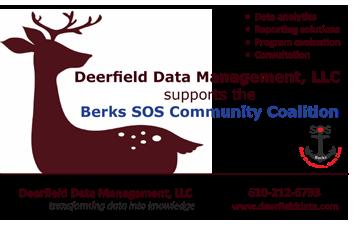

As posterity has shown, the subjects our community chooses to honor need to be more than just a famous face or a singular event, but a unifying message that inspires the masses. In the coming months, a dedicated group of artists, advocates, and leaders will join together to give us just that. Two murals will be erected in the City of Reading depicting the faces of recovery. They artistically portray uplifting stories of hope. They do not celebrate a victory or revere a hero but commemorate the spirit of an individual’s journey.
Each stroke of the paintbrush will represent the arduous struggle of those in recovery, and the unbelievable strength and support of their friends and family. Each stroke will recognize the thankless work of those in the trenches who provide prevention, education, and recovery support to our community. Each stroke will be in the memory of those who tragically succumbed to the disease. As the last of the paint dries, all that work will embody a message of hope and perseverance. A message that we all should feel proud to pass on to the next generation.
This edition celebrates this ideal. We celebrate their message. We celebrate that we, as a community, recognize those in recovery with empathy. And that we no longer see them through a jaded lens of stigma. On behalf of Berks SOS and The Response I hope, like our new murals, you find this edition to be a positive resource for you and our community.
THE RESPONSE // SUMMER 2023 6
LETTER FROM THE EDITOR

New trends in substance abuse stem from dangerous lab-made synthetic drugs
 By David A. Kostival
By David A. Kostival
With frequent news stories focused on the current opioid crisis, we often view drug abuse as a modern-day problem which gets progressively worse with each year. And while statistics do show a steady growth in drug-related deaths over the last twenty years, the problem is not new. According to the National Library of Medicine, there was extensive drug use in the United States around the time of the first world war involving a combination of morphine, heroin, opium and cocaine.
The truth is that substance abuse evolves based on societal trends. Berks County Detective Sergeant Pasquale Leporace said one of the current trends stems from the legalization of recreational marijuana. “I think that once marijuana was legal in certain states, we saw a big trend in people wanting the marijuana from Colorado and California, even though it was twice as expensive as the marijuana that came from Mexico,” Leporace said. “I think that cut back on a lot of the money that the Mexican cartel was making on marijuana.” At that point, about 10 to 15 years ago, Pasquale explained Mexican marijuana fields were converted into poppy fields.
Fentanyl is a synthetic opioid which has FDA approval to treat severe pain, but over the past 10 years the drug has been made and distributed illegally. The sometimes-lethal combination of fentanyl and heroin has overwhelmingly contributed to the rise in overdose deaths.
“I think that’s when the market started getting flooded with heroin, but meth also started becoming a big product,” Leporace said. “Before that, it was very rare in cities. We saw meth mostly in the rural areas being produced by motorcycle gangs. But then about 15 years ago, Mexico started getting into producing their own meth and flooding the market with
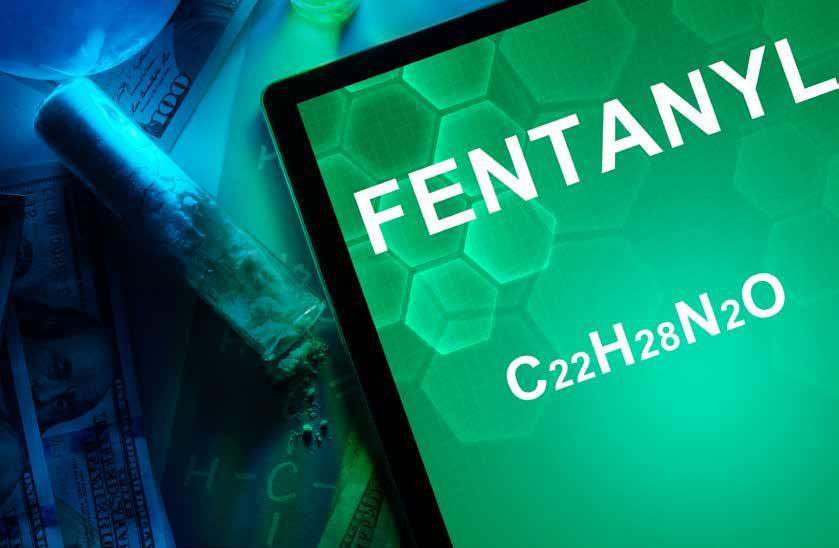
THE RESPONSE // SUMMER 23 8 FEATURE
it.” Berks County Lieutenant Nelson Ortiz said meth was easier to produce than growing marijuana or heroin. “Meth is easier because it’s something that you can make in a laboratory, where with the cocaine you have to have a crop,” Ortiz said. “And you have crop seasons and that’s not as cost effective. Plus, most of the crops are not necessarily in Mexico, but in a lot of other Latin American countries.”
Ortiz said there is also greater availability throughout the county because mid-level drug dealers tended to move out of the city because they felt they were safer in surrounding municipalities. “We get a lot of cross investigations with Montgomery County, and it seems like a lot of Montgomery County people come here for their heroin or for their cocaine, or for their meth, as opposed to going to Philadelphia,” Ortiz said. “I think they feel they’re safer coming here.”
Ortiz said the drug problems do influence violent crime and that he believes it causes an uptick in minor crimes. “So that’s one of the things we focus on too, we try to go after not just an organization that’s just selling drugs, but also organizations that somehow involve some sort of violence.”
“Anytime you have heroin, there’s probably fentanyl in it,” Ortiz said. “It’s all about profits. It’s easier to produce fentanyl than to produce heroin. Sometimes people are buying what they think is heroin and it’s all fentanyl. And that’s one of the reasons why people overdose because they have no idea that’s what they’re taking.”
Ortiz said he always tells users that their next hit may be their last because they do not know what they are ingesting. “We just had a case where there were small traces of fentanyl in gummies,” Ortiz said. “So, you just don’t know. Fentanyl is being put in everything. People may think they’re taking an ecstasy pill, but it could contain all fentanyl. Anytime the user takes drugs, it’s like playing Russian roulette.”
Leporace said a local trend affecting the local community, but is also prevalent at the national level, is an uptick in fake prescription pills. “On the black market there are prescription pills which include fake OxyContin, Percocet, Vicodin and I even heard of Adderall that is actually Fentanyl-based with dilutions in it, causing people to die,” Leporace said. “There’s a correlation (between the fake pills and overdose deaths) because there’s no quality control on the black market and there’s no ingredient labels.”
Another trend is the accessibility, especially to young people. “They have more availability to experiment with or they have many more products that will lead them down the path,” Leporace explained. “Youths can go to the corner bodega and get a gummy that has CBD oils, so the access from point A to point B has a multiple of steps, and it’s easier to go from step to step to step.” Leporace said that in the past, youths went from drinking alcohol to abusing hard drugs, but in today’s world the slope isn’t as steep, but rather a step-by-step slow climb.
Leporace said going forward, he believes that the synthetic drug market will continue to expand. “It’s easier and more cost effective, so I think synthetic drugs are going to overtake the marketplace,” Leporace said. “We’re slowly seeing that we don’t see heroin as much as we used to. It’s more fentanyl based.
Ortiz said there is also an increase in cocaine. “I personally thought that cartel was trying to push more meth than coke, but we are now seeing a big comeback. We’re working on cases now where kilos and kilos of cocaine are coming into Berks County.”
A positive trend going forward is that law enforcement has a different perspective. “Law enforcement likes working with organizations like the Council on Chemical Abuse,” Ortiz said. “We want to be part of the solution because we need education, and we need treatment.
“Obviously there’s some people, especially violent criminals, that need to be locked up, but users need treatment,” Ortiz added. “We’re involved in making sure that every Police Department in the county has Narcan available for drug overdoses. And we’re also involved with the Blue Cares program to make sure that these people that are revived through Narcan get a visit from a police officer and a treatment specialist.”
Because of the newest dangers involved with ingesting synthetic drugs, Leporace said parents need to interact with their kids to educate them about all of the possible negative effects.
“Expose them to the dangers of what’s out there because there are those CBD products that mimic gummy bears or some type of edible that would be attractive to a young person,” Leporace said. “You have influence over kids, to educate them and make them aware of the pitfalls.”

9
“Fentanyl can also be made in a laboratory, as opposed to the crops needed for heroin,” Ortiz added.
Behind the Vaping Epidemic: The Art of Deceptive Marketing
 By Alicia Kline, MS, CPS, and Marcia Goodman-Hinnershitz, MSW
By Alicia Kline, MS, CPS, and Marcia Goodman-Hinnershitz, MSW
Words. Are. Powerful. Words provide the vessel for our communication with the world. Words help to formulate and articulate our perceptions of the world. Therefore, the intentional selection of words to provoke specific thoughts or feelings, becomes a very powerful weapon towards manipulating desired behaviors or the motivation to engage in certain behaviors. Unfortunately, words often create unrealistic, untrue, and misguided understanding of our environment. Choosing the correct words persuades consumers to ignore science. Choosing the correct words builds billion-dollar companies and can maintain a public health crisis for almost 100 years.
The tobacco industry, selling its deadly addictive products, has mastered the art of using words through marketing manipulation and advertisements. Before the ban on cigarette advertisements on television, tobacco companies marketed cigarettes during Saturday morning cartoon shows. Winston created an advertisement using the popular youth cartoon characters the Flintstones, suggesting that smoking helps you to relax and have fun. In the late 1980s, Camel introduced their cartoon mascot, Joe Camel. Joe Camel was cool, and you could earn cool Joe Camel merchandise by collecting points off a box of cigarettes. During this time, Marlboro also began their “miles” program where smokers could earn miles from each pack of cigarettes they purchased and convert those miles into merchandise. Tobacco companies offered coupons, to help with the growing price of cigarette taxes1
Surprisingly, the battle between science and tobacco dates to the 1600s. Many countries banned its use and even churches have excommunicated anyone caught smoking in holy places. In 1912, American physician Isaac
THE RESPONSE // SUMMER 2023 10 FEATURE
Adler wrote the first comprehensive research study on the correlation between smoking and lung disease. By the time the United States Surgeon General Luther L. Terry released the Surgeon General’s Advisory Report on Smoking and Health in 1964, over 7,000 articles were published related to smoking and lung disease2. Despite releasing 34 additional reports over the last 50 years including thousands of scientific studies, cigarette smoking remains the leading cause of preventable death in the United States. Nearly 500,000 Americans die each year from lung related-diseases due to smoking and while tobacco use continues to decline each year, over 30 million American continue to smoke. Why? Why do people start or continue to use tobacco products? People use tobacco products for numerous reasons, and we cannot suggest or list every reason for their use. However, we can examine the extensive role the influence of tobacco marketing strategies played as a significant reason for tobacco use in the United States.
Simple magazine advertisements first appeared in the United States in 1798. Since those first advertisements, tobacco marketing developed into highly sophisticated marketing strategies that skillfully persuaded the public to continue using their products despite scientific evidence. During the infancy stages of lung disease research, when less than a third of physicians were convinced of the health risk associated with smoking, tobacco companies convinced doctors to appear in their advertising. Images of doctors smoking and endorsing the product help to create an illusion of safety in the public minds about using tobacco products3. As another tactic to confuse the public, Big Tobacco funded independent studies to manipulate and highlight specific data in a positive way.
Science continued to fight back. On January 11, 1964, Luther L. Terry, M.D., Surgeon General of the U.S. Public Health Service, released the first report of the Surgeon General’s Advisory Committee on Smoking and Health. The report concluded that cigarette smoking is:
• A cause of lung cancer and laryngeal cancer in men
• A probable cause of lung cancer in women
• The most important cause of chronic bronchitis
By the late 1960s, most physicians understood and supported current lung disease research and refused to endorse tobacco products. Furthermore, as scientific research expanded, Big Tobacco could no longer use the excuse that the evidence was inconclusive. Big Tobacco also faced several government regulations which removed all television and radio ads. However, tobacco companies adapted and shifted focus to print ads and created ads that made tobacco look young, sexy and fun. Phillip Morris pushed their Marlboro man ads, the ruggedly handsome cowboy that every man wanted to be, and every woman wanted to be with. Despite any regulations Big Tobacco always marketed their products to youth.
Berks County Secondary School Youth Tobacco and Vaping 30th day Use (Pennsylvania Youth Survey)

2015 2017 2019
History is repeating itself. Rates of youth smoking continue to decrease due to successful prevention efforts and enforcement of federal tobacco control regulations. However, the tobacco industry marketing practices targeting vulnerable youth has resulted in a new health epidemic.
A disturbing fact is that it required forty years of concentrated public health efforts, supported by the first Surgeon General’s report, before we started to see a decline in adult cigarette use. But Big Tobacco doesn’t stay down for long. There is too much profit from the sale of products containing addictive chemicals such as nicotine. With cigarette smoking on the decrease, the tobacco industry quickly regrouped and turned its energies to the promotion of other forms of nicotine delivery. In 2007, enter the electronic cigarette and vaping into the United States. Electronic cigarettes created a new and lucrative revenue stream for tobacco companies with unregulated products to market to the generation of technology-loving youth.
Electronic cigarettes emerged under the guise of a “harm reduction” strategy. The tobacco industry promoted electronic cigarettes as a “safer” alternative to smoking and thus created a marketing buzz that would seek to legitimize this product. The fact that vaping products contain addictive nicotine was never revealed. Thus a new means of the delivery of nicotine to unsuspecting consumers was born.
continued on next page
11
0 5% 10% 15% 20%
Youth Vaping Overpowers Cigarette and Smokeless Tobacco Use
The tobacco industry, with its previous successes in targeting youth, recognized that billions of dollars of new revenue could be realized from the youth vaping market. Therefore, the tobacco industry was not satisfied in directing its marketing solely to the adult consumer as an alternative to smoking. Rather the industry put in motion sophisticated marketing strategies directed at youth. Juul Labs, the maker of the most popular U.S. e-cigarette, launched its aggressive youth campaign in 2015. This campaign utilized social media influencers and launch events to glamorize vaping. While Juul Labs fervently denies its marketing campaigns target youth, the Federal Drug Administration, and academic researchers, such as the Stanford Research into the Impact of Tobacco Advertising, have found clear evidence of a JuuL-driven youth nicotine epidemic.
According to the National Youth Tobacco Survey (NYTS), the dramatic increase in high school e-cigarette use coincided with the JuuL marketing promotions. Youth use of this dangerous substance increased by 135% from 2017 to 2019 (from 11.7% to 27.5%)4. Researchers at the University of Michigan who conduct another national youth survey, the Monitoring the Future Study, found that the increase in youth nicotine vaping from 2017 to 2018 was the single largest one-year increase in youth use of any substance in the survey’s 43-year history5.
Public health studies have clearly demonstrated the dangerous and addictive chemicals contained in electronic cigarettes. Nicotine used during adolescence can harm the developing brain. Other chemicals found in electronic cigarettes, such as acrolein, can cause irreversible lung damage. As the most popular electronic cigarette used by youth, one JuuL pod contains as much nicotine as a pack of cigarettes. A JuuL pod contains nicotine salts that do not produce vapor or visible emissions. This cartridge-based delivery system may make the product more addictive than cigarettes6. Therefore, the
promotion of electronic cigarettes by the tobacco industry as a safer alternative to cigarettes, is a misrepresentation of a far deadlier product.
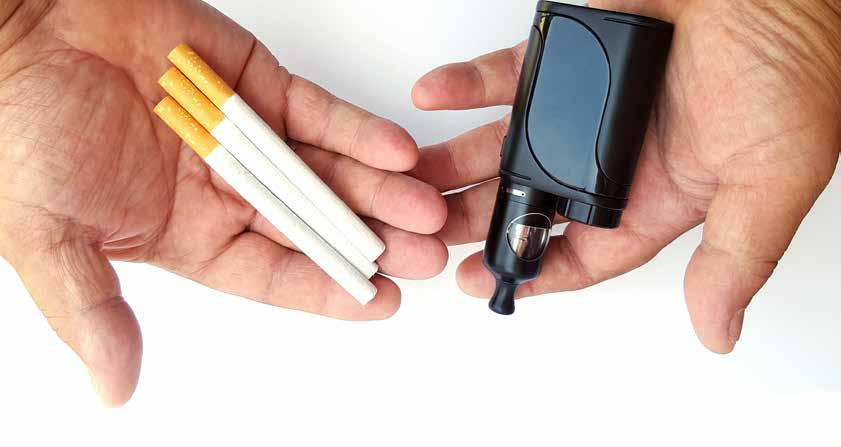

The need for more stringent controls of electronic cigarettes by the Federal Drug Administration (FDA) is critical to the health and well-being of our youth. On Aug. 8, 2016, all e-cigarettes and other electronic nicotine delivery systems (ENDS) products became subject to the FDA’s tobacco authorities, including the premarket authorization requirements in the Federal Food, Drug, and Cosmetic Act (FD&C Act). All electronic cigarettes and other ENDS products on the market at that time needed to have authorization from the FDA to be legally marketed.
However, the actual enforcement of its regulations is at the discretion of the FDA. All ENDS products currently on the market can be considered illegally marketed since no products have been authorized by the FDA. Priority enforcement by the FDA is directed to the following:
• Any flavored, cartridge-based ENDS product (other than a tobacco or menthol-flavored ENDS product).
• All other ENDS products for which the manufacturer has failed to take (or is failing to take) adequate measures to prevent minors’ access; and
• Any ENDS product that is targeted to minors or likely to promote use of ENDS by minors7.
THE RESPONSE // SUMMER 2023 12 FEATURE
By setting these priorities, the FDA is responding to the public health concerns related to youth use of ENDS (vaping) products while not specifically countering the rationale of the tobacco industry that ENDS products assist addicted adult cigarette smokers in transitioning away from smoking. The FDA regulations represent an important step in curbing youth use of addictive vaping products. Any delays or inconsistencies in comprehensive enforcement of ENDS regulations could have catastrophic health impacts as more youth turn to vaping.
The tobacco industry’s marketing strategies and lobbying power with respect to electronic cigarettes provide a harrowing example of profit versus public health. For prevention advocates, taking on Big Tobacco is like David fighting Goliath but our dedication to protecting our communities and our youth provides the motivation to keep searching for the triumphant sling shot that takes down the giant. Empathy and understanding provide the foundation for developing effective strategies to attempt to end the youth vaping crisis. We must remove the blame we often place on youth for their decision making with respect to vaping. Rather, we must direct our efforts to address the impact of tobacco’s powerful marketing, advocate for comprehensive enforcement of government policies regarding the sale of vaping products, and most importantly, understand that nicotine addiction fuels the vaping epidemic. We must join together with our youth to find the “sling shot” needed to counter the dangerous and deadly strength of the “Goliath” tobacco industry.
Sources:
1 “The History of the Discovery of the Cigarette,” Tobacco Control 2012; 21:87-91.
2 Warning: Surgeon General Finds that Cigarette Smoking Is Even More Dangerous to Your Health | Blogs | CDC.
3 When Cigarette Companies Used Doctors to Push Smoking - HISTORY.
4 Wang, TW, et al., Tobacco Product Use and Associated Factors Among Middle and High School Students—United States, 2019, MMWR, 68(12): December 6, 2019, https://www.cdc.gov/mmwr/volumes/68/ss/pdfs/ss6812a1-H.pdf.
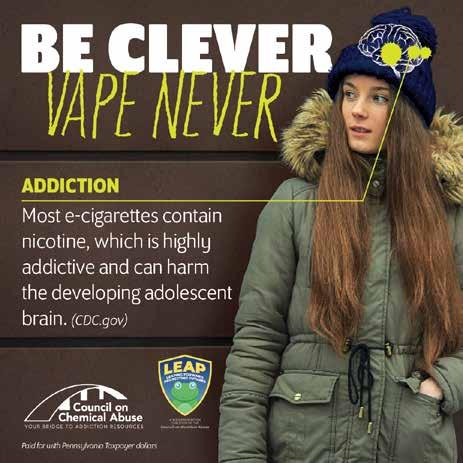
5 University of Michigan, Monitoring the Future Study, 2018. http://monitoringthefuture.org/data/18data/18drtbl3.pdf.
6 The Disturbing Focus Of JUUL’s Early Marketing Campaigns (forbes.com).
7 Enforcement Priorities for Electronic Nicotine Delivery System (ENDS) and Other Deemed Products on the Market Without Premarket Authorization | FDA.

13
Unraveling the Parent/Child Communication Struggle Care and Compassion:
By Dr. Ramona Roberts,Executive Director, Caron Outpatient Treatment Center and Author: Making Sense of What Hasn’t Made Sense and Shannon Tissera, Master level intern, Philadelphia College of Osteopathic Medicine
Being a parent is one of the hardest jobs on the planet. We somehow need to figure out how to keep these miniature humans fed, clothed and alive while concurrently doing our best to shape them into well-rounded, productive members of society.
Parenthood is hard. Especially daunting is when something that seems simple – like communication – can feel like an insurmountable challenge. Ask any parent of a toddler who is having a meltdown in the middle of the grocery store, or a parent whose teenager makes a regular habit of stomping to their room and slamming the door after a heated discussion – being understood and understanding is hard. At these times we may not even be thinking that we need to decode what these young bodies and brains are trying to tell us, but if we
build our communication toolbox, we can unravel the said and unsaid for meaningful communication that supports the child, the caregiver and the relationship.
From toddler to teen, it is possible to have open, meaningful discussions with our kids. It all begins with how we approach and respond to our children, especially when dealing with heightened emotions and difficult situations.
With consistency, our children will find safety and comfort coming to us with their challenges and triumphs. Here are a few tips to build your communications toolbox to better sort out the meaning in your child’s behavior and keep the lines of communication open.

FEATURE
THE RESPONSE // SUMMER 2023 14
Using co-regulation to manage emotions. Many of us were raised with the expectation that we need to “just suck it up and deal with it” and now as adults, we’ve carried that same mantra into our jobs, personal lives and parenting. Telling our children to “put their big kid pants on” – to calm down, to get it together – actually portrays the message that what they’re going through doesn’t matter.
Over time, kids will learn to suppress their emotions and can become isolated. The proof is in the data – a screening by Mental Health America revealed that nearly half of 11 to 17-year-olds reported that they “often do not show their feelings.” When children don’t feel comfortable expressing their emotions, it can lead to bigger problems, such as substance use, anxiety and depression. These issues often leave parents feeling guilty and hopeless, not knowing what is wrong with their child or what they may have done to “cause it.”
As parents, our job is to help our children identify and regulate their emotions, not dismiss or downplay them. Adults have the experience and ability to control our impulses, think through scenarios before acting and reason our behavior. The part of the brain that controls these functions – the frontal lobe – isn’t fully developed until we are in our mid-20s. By nature, when a child is experiencing a “meltdown” or other intense emotions, it is often not out of disrespect or disobedience; instead, it is a byproduct of their brains not yet being fully equipped to process and cope with the situation.
We can demonstrate our experience and resilience with our kids by sharing the emotional load through co-regulation. When a child is feeling overwhelmed or acting out, we need to step in and fill the emotional gaps with our own coping mechanisms. By showing them we’re here to help and validating their emotions, we can guide them to a place where they feel calm and safe.
Start
with active listening.
With all the responsibilities of adulthood – juggling work/life balance, managing our ever-growing to-do lists and coordinating family schedules – your child’s problems may seem so minor in comparison. But when your child approaches you with a problem, it’s a big deal to them and it’s important that we treat it as such.
Whether it’s a three-year-old crying because they don’t want to take a nap or a pre-teen who is upset after failing a math test, we need to put our ears, our minds and our mouths into “listening mode.” That means putting down our phones or stepping away from the sink full of dishes –to engage with our child, which conveys that we are listening.
All of us have a tape playing in our minds that is influenced by a lifetime of biases we created and experiences we’ve had. In active listening, we need to pause that tape and keep that voice inside our heads at bay. Avoid making judgements or thinking ahead about how you’re going to respond and really listen with an open mind and calm demeanor.
Are they tired, hungry or experiencing something else physically that would cause a strong emotional reaction? Slamming doors may be the teen wanting to be heard or seen. Aggressive behavior, even fighting with siblings, can be viewed through the lens of desperately needing the parent’s attention. Cursing or using inappropriate language similarly may be an attempt to get your attention. Specifically, shouting those words at you and negative comments may really be how they’re feeling about themselves but shouting them at you is easier than bearing their own emotional pain. Lack of eye contact may be that they’re overwhelmed, or conversely it may help them pay attention and stay present by feeling less threatened. Lack of effort in things may signal that they’ve been feeling their efforts didn’t get them anywhere and what’s the point of trying now. Listening is not just about their words, but what may their behavior be saying to you.
To decode what’s not being said, ask questions so you can accurately understand what they’re experiencing. Before you react, practice empathy – put yourself in your child’s shoes to understand why, from their perspective, the situation is troubling.
Respond with care and compassion, not punishment and shaming.
When emotions are running high, it can be easy to react by yelling or telling your child to go to their room. But your response can make all the difference in whether your child will feel ashamed and frustrated – or safe and calm.
Be careful not to dismiss or minimize what your child is going through. Even the most well-intended words can have the ability to be twisted or misinterpreted from our mouths to their ears. Avoid phrases like “you shouldn’t think like that” or “that’s silly/dumb.” Younger children don’t have the cognitive ability to understand the intended meaning of sarcasm and the use of it can leave them feeling confused. Children who feel dismissed or receive mixed messages tend to have ongoing emotional wounds and feel less trusting of their parents.
continued on next page
15
While we can’t always offer a solution to their troubles, we can make our kids feel validated and understood. Don’t focus on calling out their behavior or punishing them; but instead, ask them questions or provide options that will guide them to make independent choices for what comes next. Remember that when kids push boundaries, often they are hoping the parent will meet the challenge or test, and not give up on them.
Let them cry.
Tears are actually a means of self-regulation and carry stress hormones. Crying activates our parasympathetic nervous system, helping our bodies to restore a sense of balance. Allowing your child to sit with their feelings empowers them to know how to react to them in the future.
Help your child identify what they are feeling. Use empathetic phrases like: “I see how that makes you angry” or “I can understand why that upsets you.”
Know when your child is “testing the waters.”
Sometimes, a child will share something just to gauge your reaction. It could be an event that happened at school, something they saw that made them uneasy or a situation a “friend” is going through. Telling you about it is their way to proverbially “test the waters” – establishing whether they can trust you and seeing how quick you are to judge.
If you react with disbelief, are dismissive or shaming, your child will hear loud and clear that they should not share anything like this with you again – especially if it happens directly to them - as it will garner the same response.

When a child shares such information with you, show genuine interest and ask questions. How did the situation make them feel? What would they do to solve the problem? How would they have handled it differently? You’re not only showing them you care by giving your full attention, but you’re equipping them to deal with the situation and encouraging them to come to you again in the future.
Practice what you preach.
Set a good example for your kids by exercising positive communication skills around them. In conversations with other adults in the household, older children and even ourselves, don’t be quick to react or get too emotional. Take time to self-reflect and practice forgiveness. Give yourself grace as you may reflect on things you would like to do differently. Know that at any point, the present moment is a great opportunity to change up the way things have been done.
Be authentic and honest with those around you. Acknowledge that you are not perfect, and mistakes are an opportunity to do better. If something didn’t go as planned, say you’re sorry – especially to your kids. Apologies help build and retain trust. Contrary to what some adults may think, they improve respect both ways.
Focus on connection, not control.
As children get older, they become more independent and look to their peers to work through their problems. If parents interfere too much or try to be controlling, it can push the child away.
Sometimes, just knowing that you’re there can help your child feel safe and when they need it, they’ll feel comfortable coming to you. In the meantime, continue looking for ways to establish an ongoing connection with your child. Sit down for a meal together on a regular basis. Establish a family game or movie night. Cheer them on at their games or performances. Show interest in the things they are into, even if it’s endless episodes of Bluey or playing hours of Minecraft.
Celebrate them for who they are as human beings. No matter what age, you are their parent and their world. The compassion and love you show for them now will stay with them through the rest of their lives.
THE RESPONSE // SUMMER 2023 16 FEATURE
Meet Some Berks County Medical Society 2023 Executive Board Members

President: Bill Santoro, MD, FASAM Chief, Division of Addiction Medicine, Tower Health

President-Elect: Ankit M. Shah, MD Emergency Medicine, Tower Health

Treasurer: Daniel A. Forman, DO Hematology & Oncology Specialist, Tower Health

Immediate Past-President: Jillian M. Ventuzelo, DO Family Medicine, Penn State Health St. Joseph

Read Berks County’s Medical Record Magazine

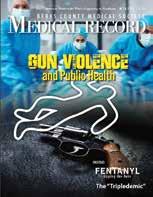





Enjoy locally and regionallygenerated content about relevant and trending community and population health topics, regulatory issues, and health care delivery news that impacts local physicians, affiliated healthcare providers, and YOU. Berkscms.org/medical-record
Tune in to BCMS HealthTalk
Hosted by physicians, HealthTalk is dedicated to information on a variety of medical conditions and hot topics.
Wednesdays from 6pm-7pm on WEEU.
Offers:
• Comprehensive outpatient evaluations conducted by a therapist trained in substance use disorders.
• A range of outpatient group counseling options for teens and adults.



• Individual counseling.
• Trauma Services.
• Critical support for family members.



• Specialized addiction program.
• Prevention and education programs.
• Recovery support for alumni.

17 In Berks County, funds are managed and distributed by the Council on Chemical Abuse
Eliminate or reduce overdose deaths. Prevent and treat opioid use disorders. Learn more at cocaberks.org/opioidfunds (610) 376-8669 | cocaberks.org Available Now in Berks County for Services that: WWW.CARON.ORG CARON OUTPATIENT TREATMENT CENTER
in Wyomissing, Pennsylvania 845 North Park Road Wyomissing, PA 19610 484-345-4670
Berks County Opioid Settlement Funds
Located
Find a Doctor! BerksDoctors.com BERKS COUNTY MEDICAL SOCIETY Health & WellnessDIRECTORY 2022-2024 2022-2024 BERKS COUNTY MEDICAL SOCIETY HEALTH & WELLNESS DIRECTORY www.berkscms.org
Serving Berks County for 200 Years
The 2023 Berks Medical Society
Prescription Take-back Day –A Successful Event
 By T.J. Huckleberry, Executive Director, Berks County Medical Society
By T.J. Huckleberry, Executive Director, Berks County Medical Society
264 Cars, 453 pounds of Returned Medications

and a Taxi
The major drug problem in the United States is not on the street, it is in our medicine cabinets. Unused or expired prescription medications are a public safety issue, leading to accidental poisoning, overdose, and abuse. Pharmaceutical drugs can be just as dangerous as street drugs when taken without a prescription or a doctor’s supervision. The majority of teenagers abusing prescription drugs get them from family and friends – and the home medicine cabinet. Unused prescription drugs thrown in the trash can be retrieved and abused or illegally sold. Unused drugs that are flushed contaminate the water supply. Proper disposal of unused drugs saves lives and protects the environment.
On April 22, 2023, the Berks County Medical Society partnered with the Fightin’ Phils, the Berks County Office of the District Attorney and the SOS Berks Opioid Coalition to sponsor the 2023 Prescription Take-back Day. This annual event offers Berks Countians a safe,
THE RESPONSE // SUMMER 2023 18
FEATURE
Senior Citizen in a
Facts about Xylazine
Xylazine is a veterinary tranquilizer that is sometimes added to fentanyl. It’s also known as “tranq” and as “anestesia de caballo” in Puerto Rico
A GROWING THREAT INCREASED RISK

From 2015-2020 the percentage of overdose deaths involving xylazine in PA increased from 2% to
26%
Xylazine has been associated with severe, chronic wounds that can worsen quickly and require medical attention.
Xylazine and fentanyl drug mixtures place users at a higher risk of suffering a fatal overdose.
Experts recommend administering Narcan anytime someone is experiencing an overdose, but Xylazine is not an opioid, so naloxone does not reverse its effects.
NOT APPROVED FOR HUMAN USE
Xylazine has been approved by the FDA as an animal sedative. It is not considered safe for humans.
convenient, and responsible method of disposing of both prescription and over-the-counter medications while at the same time connecting participants with local safe medication management resources. And as an added incentive, free tickets to an August Fightin’ Phils game are provided to all individuals who drop off their unused medications.
The 2023 event demonstrated the teamwork needed to properly dispose of large quantities of medication. Public safety personnel from the District Attorney’s staff and the Reading Police Department oversaw the handover of the medications while volunteers from the Berks County Medical Society and Drexel University sorted and prepared the medications for transfer to the Berks County Forensics Unit van. The medications are then transported to the appropriate sites for safe disposal. And SOS Berks volunteers were on hand to provide educational packets to all participants including medication disposal bags and pill storage boxes. This year’s event also sought to protect the environment by disposing of the medication containers in a separate bin for recycling.
The 2023 Prescription Take-back Day faced its challenges as volunteers worked outside in damp and chilly weather. But despite the weather, this event was one of the most successful. Cars were lined up at 8:30am with individuals patiently waiting to hand over their medications. And one resourceful senior citizen even used taxi transportation to bring her unused medications to the event. Over three hours, 264 cars came
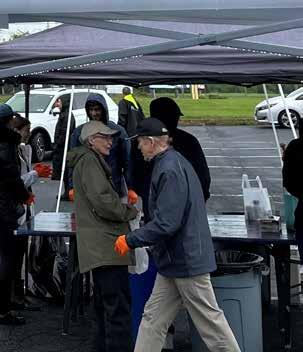
through or an average of 1.5 cars per minute. And the event resulted in the collections of 48 pounds of controlled and 405 pounds of non-controlled medication or 453 total pounds (over one quarter of a ton).
The Prescription Take-back Day is just one opportunity to dispose of your medications wisely. Medication drop boxes located at Berks County police departments and medication disposal bags provided by the Council on Chemical Abuse offer year-round options for safe medication management. Click on Medication Safety - Council on Chemical Abuse | Your Bridge to Addiction Resources (cocaberks.org) to learn about the resources available for you and your family.
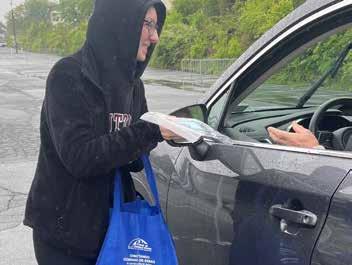
19
NIDH NIH gov DEA gov DEA gov
US Food & Drug Administration
By Laura Catalano
Mural Project
On a rainy Friday afternoon in March, about a dozen members of the SOS Berks Opioid Coalition gathered at Albright College’s new Total Experience Learning art studio for an unusual meeting.



The group, which convenes regularly to address issues related to the opioid crisis in Berks County, had come together to work on a unique project that, when finished, will convey a powerful message of hope and recovery.
Brandishing paint brushes, they began the simple, meditative task of painting in the swirling, pre-drawn lines on panels of what will become the first SOS Berks Mural.
When finished, the mural will consist of 60-plus panels that will be adhered to a building beside a popular Hispanic market located on the corner of 8th & Oley Streets in Reading. It will feature a portrait of a young man wearing a sombrero, holding a mantle that contains images from his past. The background is a lush beach overhung with palm leaves, replete with sunset colors, and a young boy struggling with a kite.

The mural is based on the recovery story of Jose Lugo, who struggled for many years with substance use disorder. Today, he serves as President/CEO of Recovery Coaching Services in Reading.
He credits his recovery to the support of his family and the memories he formed during his youth in Puerto Rico. He hopes the mural reminds all who view it of the role relationships play in helping people recover.
“This mural reflects the importance of the family in recovery,” he said. “That early unconditional love and caring my family gave me helped me through those tough times.”
THE RESPONSE // SUMMER 2023 20 FEATURE
Top Photo: Jose Lugo and Leslie Ramos hold up an image of the mural which Ramos designed, based on Lugo’s recovery story.
Bottom Photo: Pictures of COCA Staff and SOS Berks members painting.
A series oF murals
SOS Berks has a vision for developing a series of murals throughout Berks County that share stories of county residents in recovery. The murals are intended to help reduce stigma and communicate hope.
“The SOS Berks membership is excited for these murals with recovery messages to be seen by Berks County residents. The artwork is amazing and the murals are a beautiful and innovative way to convey that people do recover and live meaningful, productive lives,” said Kathleen Noll, Executive Director of the Council on Chemical Abuse and Co-chair of SOS Berks.
The murals are an extension of a stigma-reduction campaign the coalition undertook several years ago that focused on the message “Addiction Doesn’t Define Anyone,” and featured short videos from people in recovery telling their stories.
But the idea of sharing stories of recovery through community art projects was not originally part of that campaign. That came much later, following the 2021 completion of the “Hope Blossoms” mural located on Franklin Street in Reading and sponsored by the Berks County Suicide Prevention Task Force as part of its ruOK Berks campaign.
That mural, which spells out the word HOPE atop eyecatching and colorful imagery surrounding a silhouette of a flower-filled head, aims to erase the stigma of mental illness and raise awareness of suicide prevention.
When then-Berks County Commissioner Kevin Barnhardt, a former co-chair and founding member of SOS Berks, saw “Hope Blossoms,” he proposed undertaking a similar project to provide hope for recovery and reduce stigma against those struggling with addiction.
That idea was well-received by the coalition, whose members set about seeking possible locations and partners, and who quickly latched onto the concept of developing a series of murals to relay many different stories of recovery.
To date, two locations have been identified, and two murals designed. In addition to the 8th & Oley mural, there is a second mural based on the recovery story of Council on Chemical Abuse Community Program Specialist Yvonne Stroman that will be located near the campus of Albright College on 11th and Richmond Streets.

A community project
The SOS Berks murals would not be possible without the partnership of Albright College and Mike Miller. A former high school art teacher for the Wyomissing School District, Miller is the founder of Berks Community Murals and is currently an artist-in-residence at Albright College.
Over the past 20 years, Miller has coordinated more than 50 community art projects in collaboration with local organizations, including “Hope Blossoms.”
He believes that the value of a public art project lies not only in the aesthetic beauty it provides, but also in the collaborative nature of producing the art. Everyone who touches the art, who paints their small section of a sky or leaf or lock of hair, feels forever connected to that work.
“The artwork is beautiful. But having hundreds of people paint it makes it so much better,” Miller said.
SOS Berks and Miller are organizing numerous painting sessions, so that many different community groups and individuals can participate in painting the murals. The fact that so many people will contribute makes it a particularly fitting project for SOS Berks, which is itself a community coalition.
“Substance misuse and substance use disorder are issues that impact the entire community,” said Berks County Commissioner Michael Rivera, who is also the Co-chair of SOS Berks. “These murals will not only engage many, many community members during the painting process, but they will provide a profound message of hope that will be highly visible within our community.”
continued on next page
The process OF creAtIng a mural
The first step in creating the murals was to identify the people whose stories would be reflected in the artwork, and then to find local artists who could use those stories as a springboard to develop a design.
Once the design is completed, the artists work with Miller to project the artwork onto a wall, where it is enlarged and hand-drawn onto numerous panels on a material known as parachute cloth. They create a paint-by-number image, with numerous swirling sections, and then mix paints that are numbered according to the colors in the image.
When community groups arrive at a painting session, they are provided with paints in numbered plastic containers, and brushes. They simply need to fill in the spaces associated with their numbers.
While there, they will also have the opportunity to learn more about the work of SOS Berks, and to add their voices to the conversations around addressing the opioid crisis.
“Bringing all these people together—that’s what this is all about,” said Miller.
To learn more, or to sign up to help paint, visit sosberks.org.
Jose’s sTory
Artist Leslie Ramos met with Jose Lugo last year, and as he told his story she listened, took notes, and sketched out scenes in her notebook.
Jose talked about growing up on a farm in Puerto Rico, his love of horses, the beauty of the land, the deep connection he had to his family. He confided how, as a young teenager, he came to America and soon after began taking drugs. For many years he struggled with addiction, incarceration and attempts to recover. His family never gave up hope. They supported him and that support, that love, sustained him and ultimately led him to recovery.
He talked about a recent trip to Puerto Rico, during which he visited a beach, accompanied by a young relative flying a kite. That simple act is one of many things he can enjoy and appreciate because he is in recovery.
“You see me sitting here,” he told Leslie during that interview. “But what you are not seeing is my family is surrounding me, rejoicing in my recovery.”
Leslie captured as many elements as possible into the mural she created. But she made a point of doing it in such a way that it related not the story of one man, but of many people.
“In designing the mural, I mostly considered the community as a whole,” she explained. “How it could represent anyone— Mexicans, Dominicans, Puerto Ricans, anyone. And that it was something that could resonate with people.”
YvOnne’s STOry
The mural based on the story of Yvonne Stroman will be located on a building on Richmond and 11th Street, easily visible from the Albright College Total Experience Learning Building where many of the panels will be painted.
For that mural, Yvonne sat in the art studio with Berks County artist Marian Njai and told her story. As a teen, she loved athletics and reading, and she attended college intent on becoming a lawyer. But soon after enrolling, she discovered alcohol.
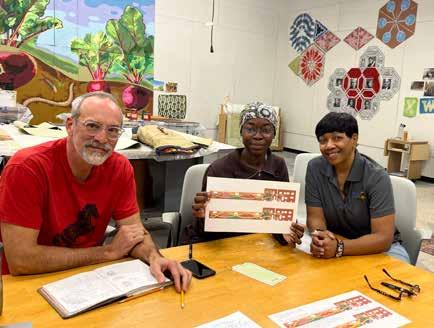

THE RESPONSE // SUMMER 2023 22 FEATURE
Bottom Photo: Albright College Artist-in-Residence Mike Miller and artist Marian Njai met with Yvonne Stroman to discuss quotes that will be used on the mural based on her recovery story.
“I really liked the feeling of alcohol. This led to years of consistent drinking,” she admitted.
She struggled for nearly a decade until, at one point, she wound up in jail and asked herself “Is this what I want for the rest of my life?”
She accepted a proposal from her attorney to go into treatment. “I said I want to go to treatment because I didn’t want to die. I was sick and tired of being sick and tired.”
Today Yvonne works for the Council on Chemical Abuse, where she manages the RISE Recovery Center and numerous other projects to support others in recovery. She finds great joy in riding her bike, mentoring young people, and helping others find their pathways to recovery.

In designing her mural, Njai incorporated a photo of Yvonne dressed in a colorful dashiki, surrounded by images of bicycles, the pathways filled with some of Yvonne’s most thought-provoking statements like “This is the journey you are supposed to be on.”

In addition to Njai, artist Gregory Didyoung digitized the photo and other patterns, some of which will be painted directly onto the building.
Yvonne said the mural deftly conveys the message of recovery as a journey. “We all come from different pathways in our journey in life,” she said. “But no matter the shade of our skin, or who we are, male or female, we all share a story of recovery. It’s a reminder of who we are.”
Recovery. Resiliency. Wellness.
Community Care, a nonprofit recovery-focused behavioral health managed care organization, manages mental health and substance use disorder services for individuals in Berks County’s HealthChoices program. Our goal is to improve the health and well-being of the communities we serve.
We offer substance use disorder services for adults, including:
• Withdrawal management
• Rehabilitation
• Medication-assisted treatment

• Certified recovery specialists
If you would like more information about services or help with your recovery, call Community Care at 1.866.292.7886.
23
“Walking in My Shoes”
The Recovery Simulation Experience
The journey to recovery is fraught with many barriers with stigma often standing in the way of individuals with a substance use disorder speaking out and seeking treatment. Stigma also prevents their family and friends from talking about this disease and reaching out for help and support. The SOS Berks Opioid Coalition recognizes the powerful impact of stigma and has been promoting stigma reduction initiatives and messaging throughout Berks County. The SOS Berks awareness and education campaigns spread the message that “Support Helps, Stigma Hurts” (Stigma Reduction - SOS Berks - Opioid Coalition). The campaign has engaged individuals in recovery, friends, family members, and professionals and has provided the foundation for on-going action to reduce stigma.
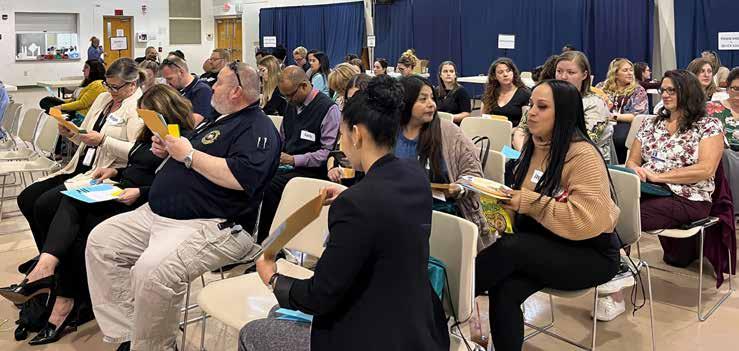
As efforts to reduce stigma have evolved, we must be mindful that connecting to a treatment program or a pathway to recovery is only the beginning. Stigma represents a formidable barrier as people in early recovery still experience stigma as they begin their recovery journey. Stigma can be found in the very helping professions and services that are put in place to assist in recovery. Professionals often well intended may not realize the barriers and challenges that existing systems put in place. Individuals without lived experience often struggle to empathize with the struggles people in early recovery face. As a field we continue to seek knowledge on the latest research on stigma and change our language to be less stigmatizing. However, without the lived experience, that is “walking in my shoes,” is something missed?
In April SOS Berks brought a unique opportunity to do just that. Give those without lived experience an opportunity on a small scale to understand what it is like to navigate many systems and services in early recovery. Live simulations have been successfully applied for a long time to address a variety of topics. Emergency response teams stage simulations for disaster training. Poverty simulations are used to help people understand the struggles of food insecurities and accessing resources. The Recovery Simulation was born out of the Carbon County Overdose Coalition. Stigma reduction is part of the SOS Berks strategic
THE RESPONSE // SUMMER 2023 24 FEATURE
“I had to let go of my values to survive!”
“It is difficult to deal with all these behaviors and still stay sober.”
plan. The simulation experience addresses stigma in a unique and immersive way. SOS Berks, along with twenty-five plus volunteers, implemented a Recovery Simulation at Easy Does It in Bern Township in April 2023.


The Recovery Simulation is based on a poverty simulation example which was adapted to fit the topic of substance use disorder including stations around addiction, elements of trauma, mental health, and re-entry. After many adjustments, our Recovery Simulation started.
There are many agencies, systems and people that interact with those in early recovery. Each person has unique challenges and varying support and resources. Individuals that show up at the doors of human service agencies often are in greater need of assistance, resources, and support. Professionals working at these organizations may also have varying levels of understanding and empathy for those desiring services. As professionals, we all carry our lived or lack of lived experience with us. Empathy is key to our effectiveness, and we need to be offering services without stigma.
The primary goal of a recovery simulation is to provide a safe environment for those without lived experience to experience early recovery. Participants should come in with an open mind and a willingness and determination to complete all the tasks demanded of those in early recovery. Once the participants arrive they are given a life card and asked to sit in the center of the room. On this card all participants receive a new name and background, including substances they used, mental health issues, involvement with the criminal justice system, employment status and living status. They are also given varying forms of resources to get them started. This could range from varying amounts of money, transportation tickets and different identification status.
Around the outside of the room are fifteen stations available to visit offering a variety of services. Each participant will have to visit specific stations depending on the services they need to complete in the week. Once the simulation starts, the group has fifteen minutes to complete the first week. Depending on what forms of identification a person has they will have to gain a social security card, birth certificate and legal identification to gain services from most stations. A transportation ticket is required each time a station is visited.
To simulate real life and the challenges we all face, there may be times when the simulation is interrupted by inclement weather, or the Court House could be closed because of a holiday. These extra interruptions mean participants don’t get all their tasks completed and must deal with the consequences. Participants could find themselves visiting the food pantry because they do not have enough money to buy food, not picking up a prescription because the pharmacy is closed, or even back in jail for violating their probation.
The whole simulation covers four weeks in fifteen minute intervals. At the end participants are given time to reflect and provide feedback on their experience through a group discussion. Through this growth experience, participants have been able to “walk in the shoes” of a person in early recovery and are now able to better empathize with the journey.

25
Taking The Stigma Away from Narcan and Fentanyl Test Strips
By David A. Kostival
In finding solutions to the drug abuse epidemic, the term harm reduction has become an important tool for those working in the field. And it has grown from being a term to a grass-roots movement for social justice for those who use drugs.

Carla Sofronski, executive director of the Pennsylvania Harm Reduction Network, said harm reduction is really a set of principles. “Harm Reduction is a set of principles made up of compassion, dignity, kindness and honesty, mixed in with evidence-based practices used to treat substance use disorder with the goal of minimizing risk and harm,” Sofronski said.
The Pennsylvania Harm Reduction Network is a statewide advocacy organization which collaborates with stakeholders which include the counties, local governments, treatment providers, people who use drugs and their families. It’s mission statement says it serves to organize and build power across Pennsylvania to end overdose deaths, drug-related
incarceration, the spread of HIV and HCV (Hepatitis C) and many other harms inflicted upon people who use drugs. “The majority of the folks that are within the network are people with lived experience, and what we advocate for is evidencebased policy and treatment programs throughout the state of Pennsylvania.”
In early March, Sofronski visited the Council on Chemical Abuse in Berks County to offer a training on the use and distribution of fentanyl testing strips. “It’s the next step in moving towards more harm reduction evidence-based practices,” Sofronski said. One of the difficulties to overcome is the fact that for a very long time there was a stigma attached to anything that enabled people who use drugs. “People have been taught and conditioned for many, many years by our treatment systems that we were not to enable people, only provide treatment-based options,” Sofronski explained. “But now we’re in 2023 in the middle of a public health crisis where Pennsylvania is the third highest state in the nation with overdose-related deaths. And we have the ninth highest in ranking in infectious diseases such as HIV and HCV, and the reason for that is because Pennsylvania does not implement harm reduction strategies.”

THE RESPONSE // SUMMER 2023 26 FEATURE
SEVILSEVAS
HARMREDUCTION
Sofronski praised Berks County for being the first leading county outside of Philadelphia and Pittsburgh to begin making changes and make a shift in the culture. “It’s saying that it is OK to be given naloxone and it is OK for folks to be testing their drugs because at the end of the day, we want to keep people alive,” she stressed. “Embracing harm reduction strategies is to be embracing other pathways to recovery, as opposed to focusing on treatment. That means starting in your own community and being vocal about it.”

Sofronski said it has been a slow evolution in making a change. “Six years ago, I would go to talk to legislators about naloxone and they would say you are enabling people, and I would say that we are enabling breathing,” Sofronski said. “And now they have statewide campaigns for the use of naloxone. We were able to shift and move that culture, and so we need to continue to keep going forward.” Naloxone — also known by the brand name Narcan — is a medicine that is an antidote to opioid drugs. Because opioids slow or even stop a person’s breathing, naloxone helps the body wake up to continue breathing.

Connect
with EDI’s recovery specialists at the Community Center of Atonement

Meet with
For more information, visit www.ediinc.org/atonement



Soberstock


















27
The next step is to ask local governments to purchase drugchecking equipment such as fentanyl testing strips. Fentanyl test strips — also known as FTS — are small strips of paper that can detect the presence of fentanyl in all different kinds of drugs, including cocaine, methamphetamine, and heroin. Even though fentanyl is an FDA-approved synthetic opioid to treat severe pain, the drug has been made and distributed illegally. That has resulted in other drugs being laced with fentanyl, which has ultimately contributed to the rise in overdose deaths. is an annual free festival to celebrate recovery in our community and spread awareness Join us at the scenic Easy Does It, Inc. campus located at 1300 Hilltop Road Leesport, PA 19533
Church
Wyomissing,
•
Lutheran
in
PA
a
specialist
•
certified recovery
to build and sustain your foundation in recovery.
•
continued on next page
“But not only to purchase (the strips) but making sure that they are getting into the hands of people who use drugs is the next step,” she added. “The best strategy to do that would be also to legalize syringe service programs throughout the state.” Sofronski explained that the program is more than handing somebody a sterile syringe, but rather having people working in the program meeting drug users with compassion and care. “It is a way to engage people and by engaging people, you give them dignity and respect with no expectations from them,” she said. It’s considered a low-barrier approach, meaning the red tape is eliminated.
“It is healthcare,” she added. “We know that people are five times more likely to go to a treatment program if they engaged in a certain service program and that’s because the component is meeting people where they are without judgement.” Most areas of the state have first responders and police doing an amazing job with administering naloxone, Sofronski said. But she added that there are still some areas of the state where it is still stigmatized, resulting in police not wanting to carry naloxone.
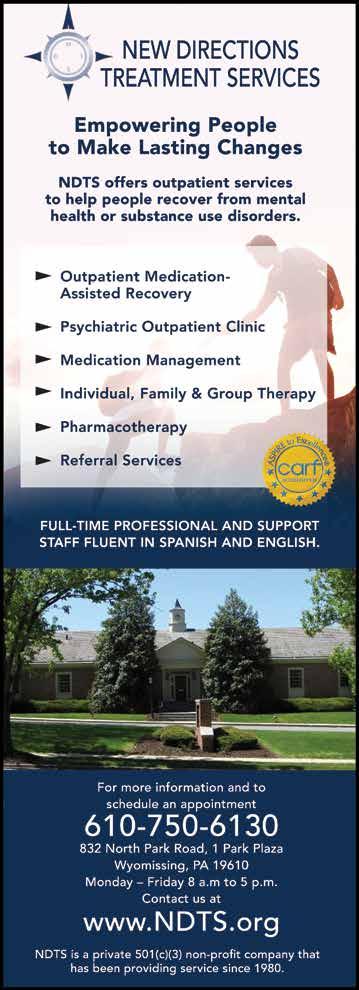
She said it’s mainly about honest education. “People think that if they were to respond to an overdose and use naloxone, they are scared and think that they may be held liable in some type of way,” Sofronski further explained. “They think if something were to go wrong that they need some type of medical training or some type of certification, and that comes down to education.”
But there’s also a message Sofronski wants people to think about. “We are watching in our country and in the state, the ripple effects of trauma that are going through our families,” she said. “And there is, if it has not already happened to you, a generation of children being raised with no parents that are suffering an immense deal of trauma, which then manifests in mental health issues and leads to substance abuse. Without implementing and learning about different strategies and being open minded, we are also going to see a generation of folks coming through that are very physically unwell due to infectious disease, and due to our poisoned drug supply and the effects that it is taking on their body.”
Sofronski said she has not met one person that hasn’t told here that the overdose hasn’t impacted them in some type of way. “What we hope with the Pennsylvania Harm reduction Network is that as one county agrees and signs on, there will be a snowball effect,” Sofronski concluded. “We need one person to take that leap first and then we can watch others follow.”
THE RESPONSE // SUMMER 2023 28

Fentanyl
WHAT IS FENTANYL?
Fentanyl is a potent synthetic opioid drug approved by the Food and Drug Administration for use as an analgesic (pain relief) and anesthetic. It is approximately 100 times more potent than morphine and 50 times more potent than heroin as an analgesic.
WHAT IS ITS ORIGIN?
Fentanyl was first developed in 1959 and introduced in the 1960s as an intravenous anesthetic. It is legally manufactured and distributed in the United States. Licit fentanyl pharmaceutical products are diverted via theft, fraudulent prescriptions, and illicit distribution by patients, physicians, nurses, physician assistants, nurse practitioners, and pharmacists.
From 2011 through 2021, both fatal overdoses associated with abuse of clandestinely produced fentanyl and fentanyl analogs, and law enforcement encounters increased markedly.
According to the Centers for Disease Control and Prevention (CDC), overdose deaths involving synthetic opioids, excluding methadone were involved in roughly 2,600 drug overdose deaths each year in 2011 and 2012, but from 2013 through 2021, the number of drug overdose deaths involving synthetic opioids, excluding methadone increased dramatically each year, to more than 68,000 in 2021. The total number of overdose deaths for this category was greater than 258,000 for 2013 through 2021. These overdose deaths involving synthetic opioids is primarily driven by illicitly manufactured fentanyl, including fentanyl analogs. Consistent with overdose death data, the trafficking, distribution, and abuse of illicitly produced fentanyl and fentanyl analogs positively correlates with the associated dramatic increase in overdose fatalities.
What are common street names?
Common street names include:
• Apache, China Girl, China Town, Dance Fever, Friend, Goodfellas, Great Bear, He-Man, Jackpot, King Ivory, Murder 8, and Tango & Cash.
What does it look like?
Clandestinely produced fentanyl is encountered either as a powder or in fake tablets and is sold alone or in combination with other drugs such as heroin or cocaine.
Fentanyl pharmaceutical products are currently available in the following dosage forms: oral transmucosal lozenges commonly referred to as fentanyl “lollipops” (Actiq®), effervescent buccal tablets (Fentora®), sublingual tablets (Abstral®), sublingual sprays (Subsys®), nasal sprays (Lazanda®), transdermal patches (Duragesic®), and injectable formulations.

How is it abused?
Fentanyl can be injected, snorted/sniffed, smoked, taken orally by pill or tablet, and spiked onto blotter paper. Illicitly produced fentanyl is sold alone or in combination with heroin and other substances

THE RESPONSE // SUMMER 2023 30
A lethal dose of fentanyl
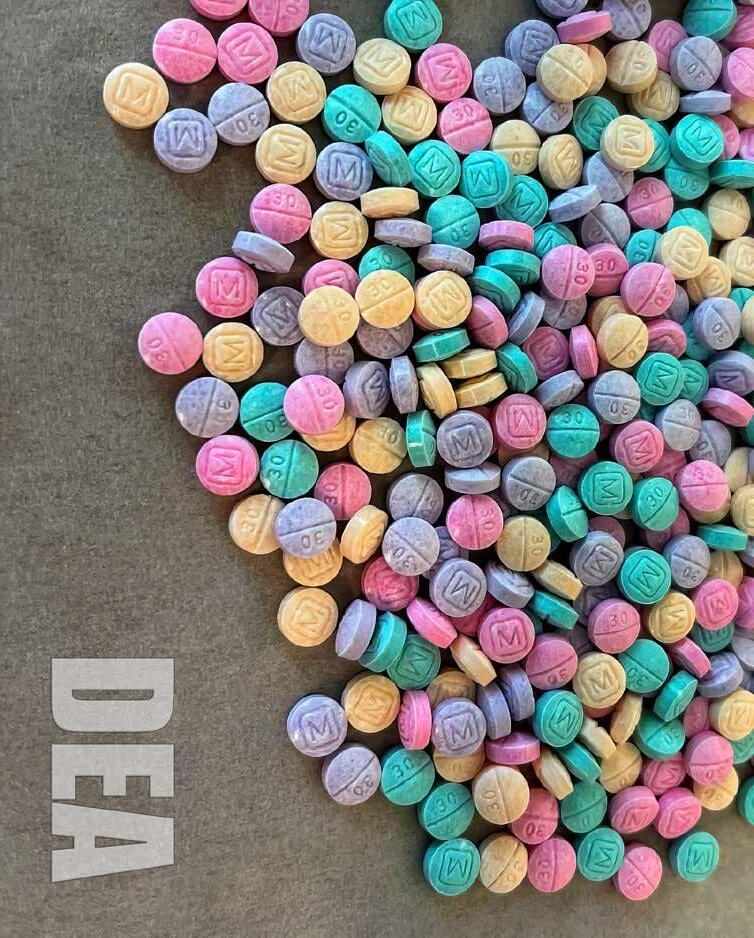
31
www.getsmartaboutdrugs.com October 2022
Fake rainbow oxycodone M30 tablets containing fentanyl
HOPE
for affordable and accessible life-saving treatment.
Hoy hay esperanza para un tratamiento a bajo costo y accesible que salve vidas
When it comes to addiction, every second counts.
Cuando se trata de adicción, cada segundo cuenta.
Today, there’s hope for saving a life with NARCAN®. Berks County residents have access to free NARCAN® opioid overdose reversal kits.
Hoy, existe la esperanza de salvar una vida con NARCAN®. Los residentes del condado de Berks tienen acceso a kits gratuitos de reversión de sobredosis de opioides NARCAN®.
There’s hope for recovery, too. Residents have access to safe, affordable, and accessible drug and alcohol treatment options right here in Berks. Virtual telehealth options are also available.
También hay esperanza de recuperación. Los residentes tienen acceso a opciones de tratamiento de drogas y alcohol seguras, asequibles y accesibles aquí mismo en Berks. También se encuentran disponibles opciones de telesalud virtual.
TODAY THERE’S
Paid for with PA taxpayer dollars. To order a Narcan® kit, find treatment, and learn more, visit cocaberks.org/HOPE. Para pedir un kit Narcan®, buscar tratamiento y obtener más información, visite cocaberks.org/HOPE .















 By David A. Kostival
By David A. Kostival


 By Alicia Kline, MS, CPS, and Marcia Goodman-Hinnershitz, MSW
By Alicia Kline, MS, CPS, and Marcia Goodman-Hinnershitz, MSW



















 By T.J. Huckleberry, Executive Director, Berks County Medical Society
By T.J. Huckleberry, Executive Director, Berks County Medical Society


































